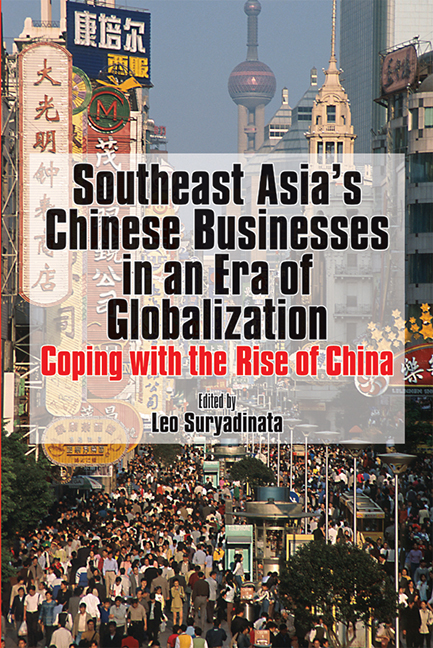Book contents
- Frontmatter
- Contents
- The Contributors
- Introduction
- China and Southeast Asia
- Indonesia
- 3 Flattening Impact of a Reawakening China on Ethnic Imbalance in Indonesian Business
- 4 The Indonesian Government's Economic Policies towards the Ethnic Chinese: Beyond Economic Nationalism?
- 5 Chinese Indonesian Business in the Era of Globalization: Ethnicity, Culture and the Rise of China
- Malaysia
- The Philippines
- Singapore and Thailand
- Index
5 - Chinese Indonesian Business in the Era of Globalization: Ethnicity, Culture and the Rise of China
from Indonesia
Published online by Cambridge University Press: 21 October 2015
- Frontmatter
- Contents
- The Contributors
- Introduction
- China and Southeast Asia
- Indonesia
- 3 Flattening Impact of a Reawakening China on Ethnic Imbalance in Indonesian Business
- 4 The Indonesian Government's Economic Policies towards the Ethnic Chinese: Beyond Economic Nationalism?
- 5 Chinese Indonesian Business in the Era of Globalization: Ethnicity, Culture and the Rise of China
- Malaysia
- The Philippines
- Singapore and Thailand
- Index
Summary
INTRODUCTION
Chinese Indonesians (also known as Tionghoa) have been acknowledged as one of the major engines in Indonesia's economic development. Although they are the minority, it is estimated that their share of total private domestic capital far exceeds that of any other ethnic group in the country. There are controversies regarding the share of Chinese capital in the Indonesian economy (for example, see Kwik 1978; Amir 1978; Hadiz 1997; and Ning 1987). Until now it has been difficult to get data about the precise composition of capital ownership. However, it has been widely accepted that the state has the largest share of domestic capital in Indonesia followed by Chinese capital.
In the year 2000, some of the major ethnic groups in Indonesia are the Javanese (41.71 per cent), the Sundanese (15.41 per cent), and the much smaller groups such as the Melayu (3.45 per cent), the Madura (3.37 per cent), and the Batak (3.02 per cent) (Suryadinata et al. 2003). The Chinese are estimated to make up 1.40 per cent to 1.99 per cent. Other ethnic groups of foreign origin also exist albeit in very small numbers (for example, Arab, Indian, Indo-European). It is estimated that there are more than 400 ethnic groups in Indonesia (Brown 1994). However, until recently there is a dichotomy between the Chinese and other ethnic groups (the so-called pribumi). In the New Order era (1966–98), the classification of non-pribumi was often applied solely to the ethnic Chinese. They were distinguished exclusively from other ethnic groups and regarded as the only alien one in Indonesia being discriminated against politically, socially, and economically during the New Order Era (see Heryanto 1997, 1998).
The ethnic group's economic roles and significance has grown significantly during the New Order era. Interestingly, in this era, they were discriminated against most extensively in the social, cultural, and political spheres. The rise of the New Order regime (1966–98) marked the peak of extensive and gross practices of racism against the Chinese involving both state discriminations, and frequent and violent mass attacks on Chinese property and life (Heryanto 1997, 1998; Ning 1987; Coppel 1983).
- Type
- Chapter
- Information
- Southeast Asia's Chinese Businesses in an Era of GlobalizationCoping with the Rise of China, pp. 102 - 161Publisher: ISEAS–Yusof Ishak InstitutePrint publication year: 2006



